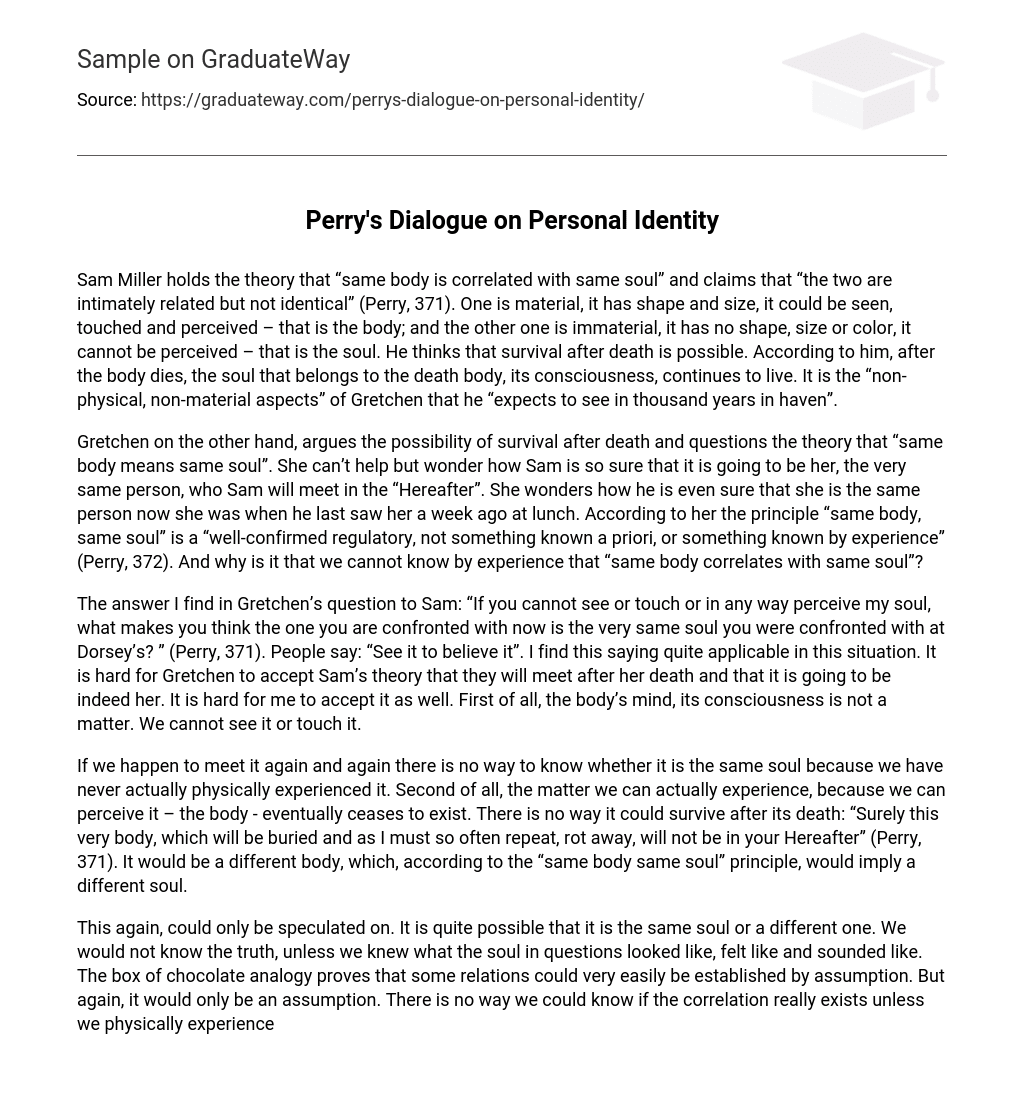Sam Miller suggests that the theory of “same body is correlated with same soul” indicates an intimate but not identical relationship between the body and soul (Perry, 371). The body, being material, possesses shape, size, and can be seen, touched, and perceived. In contrast, the soul is immaterial, lacking shape, size or color and cannot be directly perceived. Miller believes in the potential for post-death survival wherein the consciousness of the soul continues to endure after the body’s demise. He expects to witness Gretchen’s non-physical and non-material aspects in heaven even a millennium from now.
Gretchen, however, challenges the idea of survival after death and questions the belief that having the same body guarantees having the same soul. She wonders how Sam can be so certain that he will encounter her, the exact same individual, in the “Hereafter”. She even questions if she is still the same person she was when she last met Sam a week ago for lunch. In her opinion, the principle of “same body, same soul” is not inherently known or based on experience, but rather a well-supported rule. Gretchen also ponders why it is impossible to confirm through experience that having the same body guarantees having the same soul.
In Perry’s novel, Gretchen questions Sam about the identity of her soul: “If you cannot see or touch or in any way perceive my soul, what makes you think the one you are confronted with now is the very same soul you were confronted with at Dorsey’s?” (Perry, 371). This quotation brings to mind the familiar phrase “See it to believe it”, which feels relevant here. Both Gretchen and I struggle with accepting Sam’s theory that they will be reunited after her death and that it will truly be her. The difficulty arises from the intangible nature of the mind and consciousness, as these cannot be observed or physically interacted with.
It is challenging to determine if we can encounter the same soul multiple times because we have never physically experienced it. Additionally, the body, which is perceptible to us, will eventually cease to exist. When the body dies, it cannot continue, indicating that a different body would mean a different soul according to the principle of “same body same soul”.
This speculation may be applied again. It is possible that it is the same or a different soul. The reality is unknown unless we have knowledge of the appearance, sensation, and sound of the soul in question. The comparison to a box of chocolates demonstrates that certain connections can be made through assumption. However, it remains merely an assumption. The actual existence of the correlation cannot be known unless we personally encounter it. In this instance, we cannot determine that the filling is caramel solely based on the caramel swirl on top; we must actually bite into the candy to confirm.
In essence, understanding someone’s soul is as impossible as perceiving it, as the soul is immaterial. Sam’s previous experience with a certain candy filling allowed him to predict the flavor. However, he cannot predict the nature of Gretchen’s soul without prior knowledge. During the second night, Sam and Gretchen contemplate whether the soul represents one’s identity or physical body. Sam argues that neither interpretation is accurate.
According to Perry, an individual’s identity comprises interconnected segments that can be immaterial or physical. These segments, when combined in a specific manner, form a complete entity and represent the person’s consciousness at various points in time. Sam compares this concept to the “Blue River,” suggesting that regardless of the time or location from which someone views it, the river remains identifiable as the same entity.
Regardless of the cleanliness, depth, or shape of the water, or whether the banks are straight or winding, the Blue River is still recognized as such. These various components of the river are interconnected to form a unified whole. Similarly, an individual’s different states of consciousness are linked together to constitute their complete self or identity. Often, individuals tend to focus on analyzing specific aspects of their identity while neglecting its entirety. Sam also gives an illustrative example involving a baseball game.
The game is composed of different innings that can begin even when we are momentarily absent. Each inning represents a new segment of the game, yet it remains the same overall game. Likewise, people undergo various stages in life where they encounter fluctuations in mood, shifts in opinions, learning experiences, and physical transformations. Despite these changes, individuals remain fundamentally unchanged. They are comprised of multiple parts or stages that must be interconnected to constitute a complete entity.
Sam proposes that Locke’s example illustrates a relative connection through memory. According to Sam, the relation between two person-stages or stretches of consciousness that identifies them as stages of a single person is simply the presence of memories from earlier stages in later ones (Perry, 378). Remembering previous stages of consciousness defines a person’s identity in the present moment. Sam believes that the ability to retain memories of all stages of consciousness allows an individual to exist beyond death, as it is memory that shapes our essence and defines who we are.





